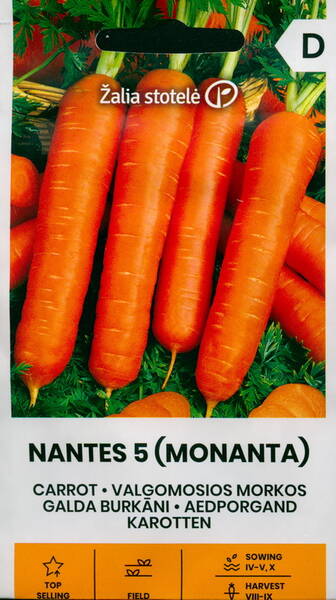Mid-early variety (from germination to harvest 90-100 days).
Root crops are cylindrical, even, 15-18 cm long, weighing up to 100-150 g, bright orange, with a rounded tip, with tender, juicy pulp and a small core.
Excellent taste, high content of sugars and carotene, combined with long-term storage without deterioration in quality until the new harvest.
The variety is high-yielding, resistant to cracking, flowering and major diseases. Grown in various climatic zones. Recommended for fresh consumption and for canning.
Agrotechnics.
It is grown by direct sowing of seeds into the ground in early spring. Seeding depth is not more than 0.5-1 cm. Row spacing is 25-30 cm. 1 gram of carrot seeds contains 800-1000 pieces.
To form large, leveled root crops, seedlings must be thinned out, leaving 2-3 cm between plants. Further care consists in regular watering, loosening the soil, and top dressing.
To obtain early production, it is recommended to sow before winter in late October - early November. Carrots grow best on light loamy and sandy soils.
Potatoes, onions, tomatoes, cucumbers, legumes are considered the best predecessors. In the spring, before sowing, a complex mineral fertilizer is applied to the soil.
Winter crops are carried out when the temperature drops to +5°C. (second half of October - beginning of November). Seeds are planted to a depth of 1-2 cm, the surface of the site is mulched.
1,0 g = 800-1000 seeds.
* To preserve root crops until the next harvest, work must begin with the correct choice of variety and compliance with agricultural technology of cultivation.
The Chantanay variety retains its qualities the longest (until the next harvest), Nantes is stored until January.
Carrots should be sown at the earliest possible time and the bed should be immediately covered with film. After the first shoots, the film is removed and watering begins. It should be moderate, uniform and quite frequent. With rare but abundant watering, root crops crack. About a month before harvesting, watering is stopped, which increases the sugar content of root crops, and they are stored well.
The application of increased doses of nitrogen fertilizers and any organic fertilizers - manure, compost, humus, etc. directly under carrots has a negative effect on the storage of carrots. But increased doses of phosphorus and potassium fertilizers, on the contrary, contribute to better preservation of the crop.












